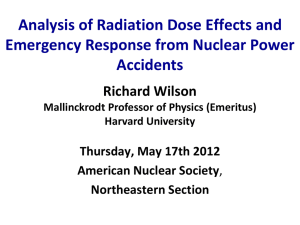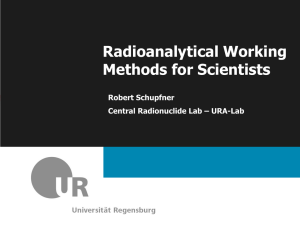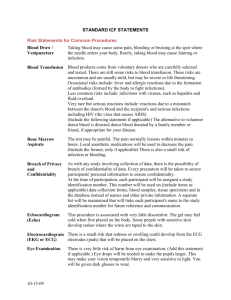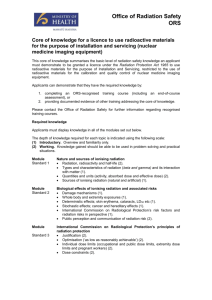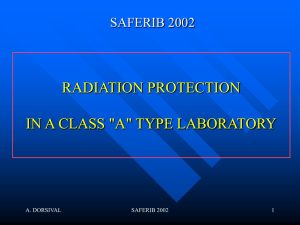12. Protection of the general public
advertisement
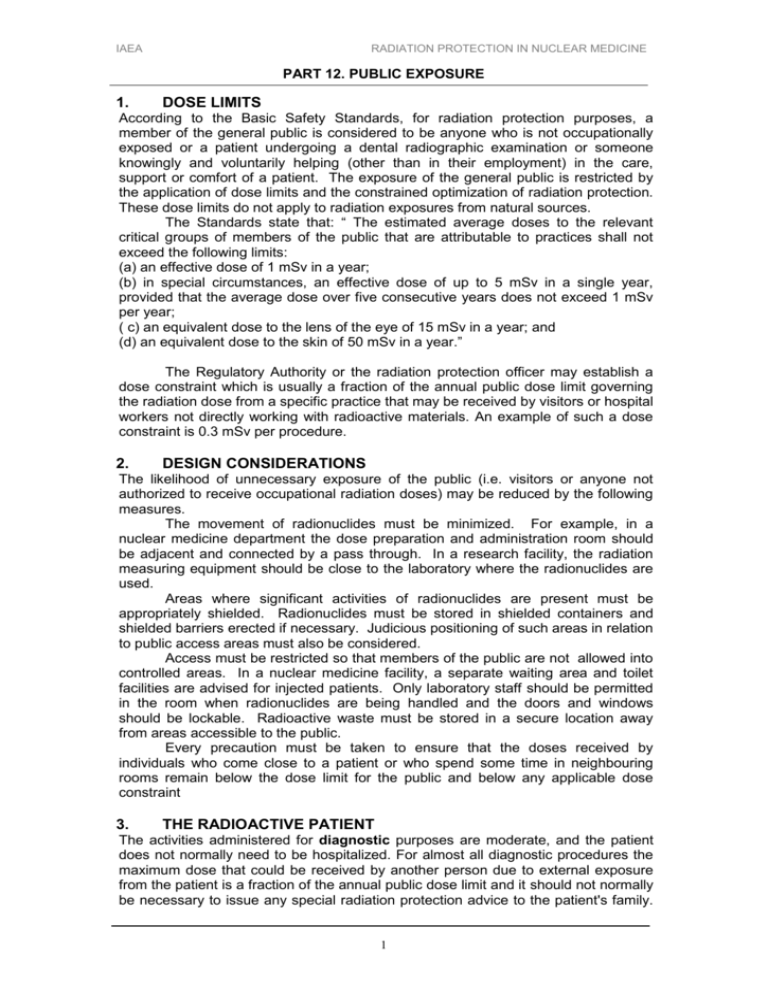
IAEA RADIATION PROTECTION IN NUCLEAR MEDICINE PART 12. PUBLIC EXPOSURE 1. DOSE LIMITS According to the Basic Safety Standards, for radiation protection purposes, a member of the general public is considered to be anyone who is not occupationally exposed or a patient undergoing a dental radiographic examination or someone knowingly and voluntarily helping (other than in their employment) in the care, support or comfort of a patient. The exposure of the general public is restricted by the application of dose limits and the constrained optimization of radiation protection. These dose limits do not apply to radiation exposures from natural sources. The Standards state that: “ The estimated average doses to the relevant critical groups of members of the public that are attributable to practices shall not exceed the following limits: (a) an effective dose of 1 mSv in a year; (b) in special circumstances, an effective dose of up to 5 mSv in a single year, provided that the average dose over five consecutive years does not exceed 1 mSv per year; ( c) an equivalent dose to the lens of the eye of 15 mSv in a year; and (d) an equivalent dose to the skin of 50 mSv in a year.” The Regulatory Authority or the radiation protection officer may establish a dose constraint which is usually a fraction of the annual public dose limit governing the radiation dose from a specific practice that may be received by visitors or hospital workers not directly working with radioactive materials. An example of such a dose constraint is 0.3 mSv per procedure. 2. DESIGN CONSIDERATIONS The likelihood of unnecessary exposure of the public (i.e. visitors or anyone not authorized to receive occupational radiation doses) may be reduced by the following measures. The movement of radionuclides must be minimized. For example, in a nuclear medicine department the dose preparation and administration room should be adjacent and connected by a pass through. In a research facility, the radiation measuring equipment should be close to the laboratory where the radionuclides are used. Areas where significant activities of radionuclides are present must be appropriately shielded. Radionuclides must be stored in shielded containers and shielded barriers erected if necessary. Judicious positioning of such areas in relation to public access areas must also be considered. Access must be restricted so that members of the public are not allowed into controlled areas. In a nuclear medicine facility, a separate waiting area and toilet facilities are advised for injected patients. Only laboratory staff should be permitted in the room when radionuclides are being handled and the doors and windows should be lockable. Radioactive waste must be stored in a secure location away from areas accessible to the public. Every precaution must be taken to ensure that the doses received by individuals who come close to a patient or who spend some time in neighbouring rooms remain below the dose limit for the public and below any applicable dose constraint 3. THE RADIOACTIVE PATIENT The activities administered for diagnostic purposes are moderate, and the patient does not normally need to be hospitalized. For almost all diagnostic procedures the maximum dose that could be received by another person due to external exposure from the patient is a fraction of the annual public dose limit and it should not normally be necessary to issue any special radiation protection advice to the patient's family. 1 IAEA RADIATION PROTECTION IN NUCLEAR MEDICINE PART 12. PUBLIC EXPOSURE The management of patients undergoing radionuclide therapy is designed to minimize radiation exposure to other persons. The precautions to be taken for ambulatory patients treated for thyrotoxicosis depends upon the amount of radioactivity administered, the radiation dose rate in the vicinity of the patient, expected normal patterns of daily contact between the patient and others, and dose constraints that may apply. All patients should be advised of basic hygiene measures (toileting, handwashing, etc) to minimize contamination of their home and work environment. Females should avoid pregnancy for at least 6 months following therapy, in case follow-up examinations might discover the need for further radiation therapy; and males should take precautions for two months to avoid beginning a pregnancy. In addition, nursing mothers undergoing radioiodine therapy are advised that complete cessation of breast-feeding is necessary As stated in the Basic Safety Standards :”In order to restrict the exposure of any members of the household of a patient who has undergone a therapeutic procedure with sealed or unsealed radionuclides and members of the public, such a patient shall not be discharged from hospital before the activity of radioactive substances in the body falls below the level specified...”. At the present time only iodine -131 has been considered as needing this precaution and a guidance level of 1000MBq has been given in the Standards. However, in some countries a level as low as 400MBq is considered good practice. In addition as mentioned in the Standards, “Written instructions to the patient concerning contact with other persons and relevant precautions for radiation protection shall be provided as necessary”. After patient discharge, the radiation protection officer should supervise the removal of any contaminated waste, the decontamination of the room and equipment; and should conduct a documented final survey of the room. When the survey and decontamination procedures are complete, the RPO should remove the radiation warning sign from the room door and notify nursing and housekeeping departments that the room is now clear for general use. 4. SPECIAL PROBLEMS Occasionally the condition of a patient treated with radionuclides may lead to death while the body still contains substantial residual activity. The rules and regulations governing the embalming, burial, or autopsy of cadavers containing substantial residual activities vary from country to country since they take account of various social, climatic, and religious factors. When a living patient is released from the hospital with significant incorporated amounts of radioactive material, the physician in charge must make certain that appropriate instructions are given to the relatives in the event of death. The most important instruction should be to contact the nuclear medicine department as soon as possible, and to delay any decisions about proceeding with arrangements for autopsy or disposal of the corpse until expert advice has been obtained. In the event of the death of a patient who has recently received a therapeutic dose of a radionuclide care has to be taken to ensure that workers and the public receive as low a dose as reasonably achievable at all stages prior to the burial or cremation. A contingency plan should be described in written instructions to the hospital staff to be implemented for radionuclide therapy patients who die while still in the hospital. The nuclear medicine department should be consulted immediately to determine (by direct measurement or calculation) the amount of residual radioactivity in a cadaver. If there is still significant residual radioactivity, the physician who declares the patient dead should attach a label to the body indicating the presence and amount of radioactivity and the radionuclide. The label should be readily 2 IAEA RADIATION PROTECTION IN NUCLEAR MEDICINE PART 12. PUBLIC EXPOSURE recognizable, legible, and easy to understand. The precautions to be taken in handling such cadavers depend on the nature and quantity of the radionuclide present and on the type of handling intended (e.g., autopsy or merely simple treatments prior to burial). As a general rule it can be said that no appreciable hazard exists unless the body is opened, when the hands and face of the pathologist could receive high radiation doses, depending on the duration of exposure and the dose rate. The autopsy of highly radioactive cadavers should be invariably restricted to the absolute minimum. It is essential that the staff should wear disposable gloves, and supplementary measures for radiation protection and decontamination should be provided in consultation with the radiation protection officer. The embalming of cadavers constitutes an undesirable hazard and should be avoided if possible. If the body is not autopsied and embalming is done simply by the injection method, the contamination risk to the embalmer is small. Nevertheless, all embalmers should wear disposable gloves. If in exceptional cases it is considered important that the cadaver should be embalmed, the process should be permitted only if residual activities do not exceed a value specified by the Regulatory Authority. The embalmers must be supervised by the RPO or designate. 5. TRANSPORTATION Transportation of radionuclides is performed both inside and outside the hospital. Inside the hospital the transportation includes distribution of the radioactive sources from the storage area to the department where it will be used. Such transport should be limited as far as possible by department design. The transport that takes place should be performed according to optimized radiation protection conditions as given by local rules. The transportation of radioactive sources to and from a hospital should follow the internationally accepted recommendations given in IAEA safety standards: `Regulations for the Safe Transport of Radioactive Material'. These recommendations include basic rules for the transport itself and regulations of the shape and labeling of the packages In general the package is built in several parts.. It should be mechanically safe and reduce the effect of potential fire and water damage. The package should be labeled with a sign. There are three different labels: IWhite, II-Yellow and III-Yellow. The label gives some indication of the dose rate, D, at the surface of the package: I- White D 0.005 mSv/h II- Yellow 0.005<D 0.5 mSv/h III-Yellow 0.5<D 2 mSv/h A more exact figure of the radiation around the package is given by the transport index which is the maximum dose rate (mSv/h) at a distance 1 m from the surface of the package multiplied by 100. 6. REFERENCES 1. INTERNATIONAL ATOMIC ENERGY AGENCY. International Basic Safety Standards for Protection Against Ionizing Radiation and for the Safety of Radiation Sources. Safety Series No.115, IAEA, Vienna (1996). 2. INTERNATIONAL ATOMIC ENERGY AGENCY. Model Regulations on Radiation Safety in Nuclear Medicine. (in preparation). 3 IAEA RADIATION PROTECTION IN NUCLEAR MEDICINE PART 12. PUBLIC EXPOSURE 3. INTERNATIONAL ATOMIC ENERGY AGENCY. Regulations for the Safe Transport of Radioactive Material. Safety Series No. ST-1, IAEA, Vienna (1996). 4. WORLD HEALTH ORGANIZATION and INTERNATIONAL ATOMIC ENERGY AGENCY. Manual on Radiation Protection in Hospital and General Practice. Vol. 4. Nuclear medicine (in press) 5. PAN AMERICAN HEALTH ORGANIZATION. Organization, development, quality control, and radiation protection in radiology services. PAHO Washington D.C., (1997). 6. HARDING L.K. et al. The radiation dose to accompanying nurses, relatives and other patients in a nuclear medicine department waiting room. Nuclear Medicine Communications, 1990, 11: 17 -22. 7. HARDING L.K. et al. Radiation doses to those accompanying nuclear medicine department patients: A waiting room survey (EANM Task Group Explaining Risks). European Journal of Nuclear Medicine, 1994, 21: 12231226. 8. O'DOHERTY M.J. et al. Radiation dose rates from adult patients receiving 131I therapy for thyrotoxicosis. Nuclear Medicine Communications 1993, 14: 160168. 9. SHIELDS RA.for the Radiation Protection Committee of the British Institute of Radiology. "The Guidance Notes Revisited: Advice to patients leaving hospital after diagnostic nuclear medicine." (editorial). British Journal of Radiology, 1991, 64: 567-568. 4


